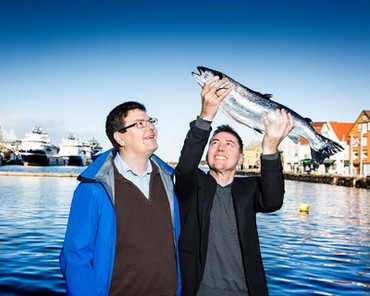Fish farming must improve or die
Published: May 9, 2014
Source : University of Stavanger, Norway
Norway’s aquaculture sector has been a world leader for innovation. But much more research is needed to avoid stagnation, according to research by two University of Stavanger (UiS) professors.

Economics professor Frank Asche and Ragnar Tveterås, a professor of industrial economics who also heads the centre for innovation research at the UiS, have both studied the industry for years.
Norwegian fish farming has been a success story, they note, particularly with Atlantic salmon. Starting small in the 1970s, it was producing more than 1.2 million tonnes of fish in 2012.
But calculations and analyses from a number of studies show that the industry must overcome major challenges if this positive trend is to continue.
Major advances
Illness, new fish farm solutions, better feed and gene technology are all areas where the academics believe a much stronger research commitment will be needed in coming years.
Illness, new fish farm solutions, better feed and gene technology are all areas where the academics believe a much stronger research commitment will be needed in coming years.
“Major advances have been made, but continued productivity improvements will become ever harder to achieve as the industry matures,” says Asche. “The low-hanging fruit has been picked.”
Big and innovative
Tveterås and Asche emphasises that the seafood sector is not only one of Norway’s biggest industries, but also among its most innovative.
Tveterås and Asche emphasises that the seafood sector is not only one of Norway’s biggest industries, but also among its most innovative.
“While many other Norwegian sectors largely adopt new advances from other countries, our seafood business is a world leader for expertise and innovation,” says Tveterås.
But research findings support their warnings. In the early 1990s, Norway’s salmon farmers had an annual production growth of 15-20 per cent. That fell to one-two per cent for 1996-2008.
It is becoming increasingly difficult for the aquaculture sector to achieve additional gains in order to maintain production growth and earnings.
Increasingly difficult
This trend comes as no surprise. Output can be sharply increased initially by expanding the area devoted to fish farming, developing better feed and improving technology. But it eventually becomes increasingly difficult to reap such benefits.
This trend comes as no surprise. Output can be sharply increased initially by expanding the area devoted to fish farming, developing better feed and improving technology. But it eventually becomes increasingly difficult to reap such benefits.
The early years of Norway’s aquaculture sector were characterised by entrepreneurs who did most of the development themselves.
"Improve or die"
As the industry increased in size, specialised suppliers emerged who competed with each other to deliver the best products to the fish farmers.
As the industry increased in size, specialised suppliers emerged who competed with each other to deliver the best products to the fish farmers.
“That’s when we got the research and innovation which have been very important for the sector,” says Asche. “This has got to continue, but requires more and more advanced expertise.
“One of our conclusions is that the research effort must be intensified in order to avoid stagnation. Industries which cease to improve will die.”
Hard to maintain
A lower rate of expansion poses several challenges, including greater difficulty in maintaining output growth through technical progress and more efficient production methods.
A lower rate of expansion poses several challenges, including greater difficulty in maintaining output growth through technical progress and more efficient production methods.
The industry will then become more dependent on external factors over which it has less control, such as market demand and government policies.
Lack of space
Another problem is lack of space. Asche and Tveterås note that growth up to the late 1990s was largely a matter of increasing the number of cages per farm and extending into new areas.
Another problem is lack of space. Asche and Tveterås note that growth up to the late 1990s was largely a matter of increasing the number of cages per farm and extending into new areas.
That expansion can no longer continue, either in Norway or in the world’s three other salmon-producing countries – Canada, Chile and the UK.
The number of suitable coastal sites is steadily decreasing and aquaculture competes with other interests over their use. A greater density of fish farms also increases the risk of environmental problems.
Prices increasingly unstable
Lack of space could explain why production has ceased to grow in Canada and Scotland, and be a major reason why farmed salmon prices have become more and more unstable.
Lack of space could explain why production has ceased to grow in Canada and Scotland, and be a major reason why farmed salmon prices have become more and more unstable.
This trend is also boosting the pressure for more radical technologies, such as enclosed cages to prevent pollutants escaping and to combat sources of disease like salmon lice.
New types of feed also need to be developed which can replace fish oil, a scarce resource. Microalgae and scraps from other fish have been mentioned in this context.
Genetic modification
Another way to boost output of some species could be genetic modification, and work on this is also under way with salmon – although most producers say they would not adopt such fish.
Another way to boost output of some species could be genetic modification, and work on this is also under way with salmon – although most producers say they would not adopt such fish.
A big commitment to research and development is needed in all these areas, according to Asche and Tveterås.
“That’s not only about money, but also about how such funds are managed,” the latter says. “This is a sector where the government has been heavily involved in research.
“Such backing needs to continue, but the industry must also make a bigger commitment and take ownership of the work. The companies need to build up internal research expertise.”
Seeking solutions
Tveterås heads a national commission which has been appointed to identify solutions for increasing value creation in the Norwegian seafood industry.
Tveterås heads a national commission which has been appointed to identify solutions for increasing value creation in the Norwegian seafood industry.
Including scientists as well as industry representatives, its work is intended to lead to an official report in the government’s NOU series.
The commission’s mandate requires it to pay particular attention to conditions which could hamper or help improve profitability and value creation.
Independent chair
Tveterås is pleased to have been appointed to chair this body: “I’m concerned to ensure that we don’t just sit in our offices and do research.
Tveterås is pleased to have been appointed to chair this body: “I’m concerned to ensure that we don’t just sit in our offices and do research.
“As an economist, I want to influence developments. The alternative is to abandon the ground to players with economic interests and a bureaucracy governed by politics. Our strength as academics is our independence.”
Source
University of Stavanger, NorwayRelated topics
Mentioned in this news release:
University of Stavanger (UiS) Norway
University of Stavanger (UiS) Norway
Recommend
Comment
Share
22 de julio de 2014
I didn't finish reading the article but "fish farming must improve or die" caught my attention. I live here in the Philippines and in my area there are still some who owns fish farms and that is where they get their money to support the family. I think it should be improved so that the locals can supply our town and we will no longer import from other areas.
Recommend
Reply
28 de mayo de 2014
fish farming must improve or die got me thinking and when I think, I write down my ideas. In Nigeria, fish farming has encountered a lot of challenges certainly not due to economic interests but basically due to inept policies as well as government bureaucracy. Now there is considerable improvements in this sector which suggests positively that fish farming must improve. I am happy to have read this piece from NORWAY and hope to write down in a paper the reasons why it should improve lest die.
Recommend
Reply
13 de mayo de 2014
We prefer Recirculation Systems. Combining the unique split loop concept with components of superior quality enables our experienced engineers to tailor each system to perfectly meet the biological requiremens of any specie both in fresh- and in saltwater. The use of a special microparticle filter provides crystal clear water without fine particles that could otherwise damage the gills of sensitive fish.
A standard Recirculation System will treat the effluent water from the fish tanks as follows:
1. Mechanical Filter - removing solid particles larger than 50 microns.
2. UV Filter - controlling bacterial dynamics and ecto-parasites.
3. CO2 Stripper - removing CO2, nitrogen and sulphide residues.
4. Bio Filter - removing organic matter and ammonia products.
5. Micro Particle Filter - removing suspended particles in the 2-50 micron range. The production unit design is imperative for a successful rearing facility, and the solution depends highly on the behavioral pattern of the species. The tank system should be designed to optimize the water flow characteristics so that exact water exchange rates for the different species and fish sizes can be achieved. For any type of tank, the inclination of the bottom has no importance with regards to the self-cleaning effect, but it makes complete draining possible when the tank is emptied.
CCRES TEAM
Recommend
Reply

Would you like to discuss another topic? Create a new post to engage with experts in the community.







.jpg&w=3840&q=75)